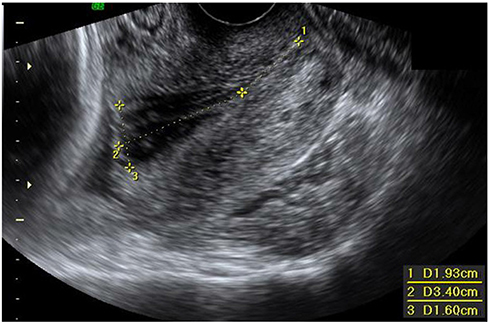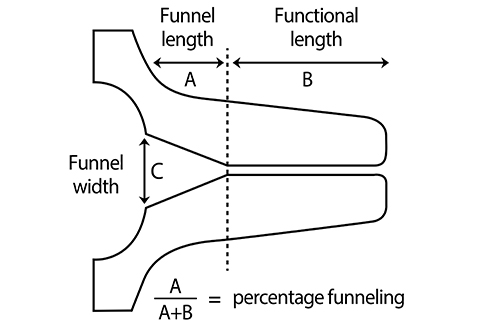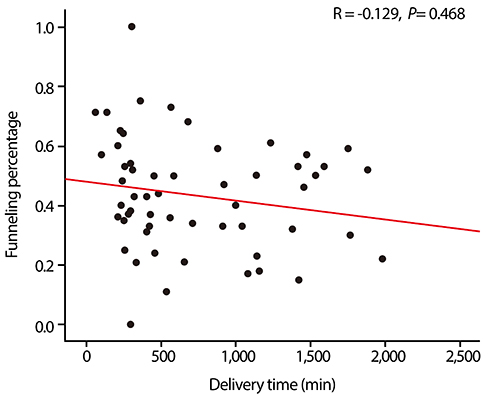Obstet Gynecol Sci.
2015 May;58(3):188-195. 10.5468/ogs.2015.58.3.188.
Sonographically accessed funneling of the uterine cervix as a predictor of successful labor induction
- Affiliations
-
- 1Department of Obstetrics and Gynecology, National Health Insurance Service Ilsan Hospital, Goyang, Korea. raksumi10@gmail.com
- KMID: 2148930
- DOI: http://doi.org/10.5468/ogs.2015.58.3.188
Abstract
OBJECTIVE
The Bishop score and length of the uterine cervix are good predictors of successful labor induction. However, little is known about the association between the funneling of the uterine cervix and successful labor induction. The study aimed to evaluate cervical funneling as a predictor of successful labor induction.
METHODS
This study was designed as a prospective observational study. Subjects who delivered a baby by labor induction were enrolled in the study from July 2011 to August 2013. Cervical funneling and length were examined with transvaginal ultrasonography. The Bishop score was rated by digital pelvic examination.
RESULTS
A total of 163 primigravida women were recruited for the study. Of these, 137 participants (84.0%) delivered vaginally by labor induction. Cervical funneling was observed in 93 women (57.1%). Successful labor induction was significantly higher in patients with cervical funneling than those without it (91.4% vs. 74.3%, P<0.01), and was significantly associated with cervical funneling, as well as the Bishop score and cervical length. In a multivariate analysis, cervical funneling was an independent predictor for successful vaginal delivery by labor induction ( odd ratio, 2.70; 95% confidence interval, 1.02 to 7.10; P=0.04). However, the Bishop score and cervical length had no association with successful vaginal delivery.
CONCLUSION
This study showed that cervical funneling could be a predictive marker for vaginal delivery during labor induction.
Keyword
MeSH Terms
Figure
Reference
-
1. Martin JA, Hamilton BE, Sutton PD, Ventura SJ, Menacker F, Kirmeyer S, et al. Births: final data for 2006. Natl Vital Stat Rep. 2009; 57:1–136.2. Cunningham FG, Leveno KJ, Bloom SL, Hauth JC, Rouse DJ, Spong CY. Labor induction. In : Cunningham FG, Williams JW, editors. Williams obstetrics. 23rd ed. New York(NY): McGraw-Hill;2010. p. 500–510.3. Luthy DA, Malmgren JA, Zingheim RW. Cesarean delivery after elective induction in nulliparous women: the physician effect. Am J Obstet Gynecol. 2004; 191:1511–1515.4. Yeast JD, Jones A, Poskin M. Induction of labor and the relationship to cesarean delivery: a review of 7001 consecutive inductions. Am J Obstet Gynecol. 1999; 180:628–633.5. Hamilton BE, Martin JA, Ventura SJ. Births: preliminary data for 2007. Natl Vital Stat Rep. 2009; 57:1–23.6. Health Insurance Review & Assessment Service. Cesarean section rate evaluation result by hospitals [Internet]. Seoul: Health Insurance Review & Assessment Service;c2013. cited 2015 Jan 30. Available from: http://www.hira.or.kr/cms/introduction/02/04/10/2013_14.pdf.7. Health Insurance Review & Assessment Service. Cesarean section rate evaluation result by hospitals [Internet]. Seoul: Health Insurance Review & Assessment Service;c2012. cited 2015 Jan 30. Available from: http://www.hira.or.kr/re/diag/getDiagEvlList.do?pgmid=HIRAA030004000000.8. Bishop EH. Pelvic scoring for elective induction. Obstet Gynecol. 1964; 24:266–268.9. Iams JD, Goldenberg RL, Meis PJ, Mercer BM, Moawad A, Das A, et al. The length of the cervix and the risk of spontaneous premature delivery. National Institute of Child Health and Human Development Maternal Fetal Medicine Unit Network. N Engl J Med. 1996; 334:567–572.10. Yang SH, Roh CR, Kim JH. Transvaginal ultrasonography for cervical assessment before induction of labor. J Ultrasound Med. 2004; 23:375–382.11. Tan PC, Vallikkannu N, Suguna S, Quek KF, Hassan J. Transvaginal sonographic measurement of cervical length vs. Bishop score in labor induction at term: tolerability and prediction of Cesarean delivery. Ultrasound Obstet Gynecol. 2007; 29:568–573.12. Berghella V, Bega G, Tolosa JE, Berghella M. Ultrasound assessment of the cervix. Clin Obstet Gynecol. 2003; 46:947–962.13. Hatfield AS, Sanchez-Ramos L, Kaunitz AM. Sonographic cervical assessment to predict the success of labor induction: a systematic review with metaanalysis. Am J Obstet Gynecol. 2007; 197:186–192.14. Crane JM. Transvaginal ultrasound cervical length and successful labor induction: a systematic review. Obstet Gynecol. 2006; 107:60S.15. Owen J, Iams JD, Hauth JC. Vaginal sonography and cervical incompetence. Am J Obstet Gynecol. 2003; 188:586–596.16. De Carvalho MH, Bittar RE, Brizot Mde L, Bicudo C, Zugaib M. Prediction of preterm delivery in the second trimester. Obstet Gynecol. 2005; 105:532–536.17. Wing DA, Farinelli CK. Abnormal labor and induction of labor. In : Gabbe SG, Niebyl JR, Simpson JL, Landon MB, Galan HL, Jauniaux EM, editors. Obstetrics: normal and problem pregnancies. 6th ed. Philadelphia (PA): Churchill Livingstone;2012. p. 287–310.18. Berghella V, Kuhlman K, Weiner S, Texeira L, Wapner RJ. Cervical funneling: sonographic criteria predictive of preterm delivery. Ultrasound Obstet Gynecol. 1997; 10:161–166.19. Spong CY, Berghella V, Wenstrom KD, Mercer BM, Saade GR. Preventing the first cesarean delivery: summary of a joint Eunice Kennedy Shriver National Institute of Child Health and Human Development, Society for Maternal-Fetal Medicine, and American College of Obstetricians and Gynecologists Workshop. Obstet Gynecol. 2012; 120:1181–1193.20. Glantz JC. Labor induction rate variation in upstate New York: what is the difference? Birth. 2003; 30:168–174.21. Garcia FA, Miller HB, Huggins GR, Gordon TA. Effect of academic affiliation and obstetric volume on clinical outcome and cost of childbirth. Obstet Gynecol. 2001; 97:567–576.22. Nora D, Susan R, Edward Y, Mary-Clare D, Alfred S, Larry G. Cesarean section: community versus county hospital. Am J Obstet Gynecol. 2002; 187:S183.23. Rane SM, Guirgis RR, Higgins B, Nicolaides KH. The value of ultrasound in the prediction of successful induction of labor. Ultrasound Obstet Gynecol. 2004; 24:538–549.24. Pereira S, Frick AP, Poon LC, Zamprakou A, Nicolaides KH. Successful induction of labor: prediction by preinduction cervical length, angle of progression and cervical elastography. Ultrasound Obstet Gynecol. 2014; 44:468–475.25. Rane SM, Pandis GK, Guirgis RR, Higgins B, Nicolaides KH. Pre-induction sonographic measurement of cervical length in prolonged pregnancy: the effect of parity in the prediction of induction-to-delivery interval. Ultrasound Obstet Gynecol. 2003; 22:40–44.26. Brieger GM, Ning XH, Dawkins RR, Ying KQ, Weng C, Chang AM, et al. Transvaginal sonographic assessment of cervical dynamics during the third trimester of normal pregnancy. Acta Obstet Gynecol Scand. 1997; 76:118–122.27. Bayramoglu O, Arslan M, Yazici FG, Erdem A, Erdem M, Bayramoglu K, et al. Prediction of spontaneous onset of labor at term: the role of cervical length measurement and funneling of internal cervical os detected by transvaginal ultrasonography. Am J Perinatol. 2005; 22:35–39.28. Peregrine E, O'Brien P, Omar R, Jauniaux E. Clinical and ultrasound parameters to predict the risk of cesarean delivery after induction of labor. Obstet Gynecol. 2006; 107(2 Pt 1):227–233.29. Pevzner L, Rumney P, Petersen R, Wing D. Predicting a successful induction of labor: a secondary analysis of misoprostol vaginal insert trial. Abstract no. 218. Society for Maternal-Fetal Medicine. In : Proceedings of the 29th Annual Meeting of the Society for Maternal-Fetal Medicine; 2009 Jan 26-31; San Diego, CA, USA. Washington, DC: Society for Maternal-Fetal Medicine;2009.30. Getahun D, Kaminsky LM, Elsasser DA, Kirby RS, Ananth CV, Vintzileos AM. Changes in prepregnancy body mass index between pregnancies and risk of primary cesarean delivery. Am J Obstet Gynecol. 2007; 197:376.e1–376.e7.
- Full Text Links
- Actions
-
Cited
- CITED
-
- Close
- Share
- Similar articles
-
- Transvaginal Ultrasonographic Evaluation of the Uterine Cervix in the Prediction of a Successful Induction of Labor in Term Gestation
- Fetal Fibronectin and Ultrasonographic Examination of Cervix: Which is Better as a Predictor of Preterm Delivery in Patients with Preterm Labor and Intact Membranes?
- Uterine Cervical Length Measurement by Transvaginal Ultrasonography for Prediction of Preterm Delivery
- Evaluation of length, volume and gray-scale histogram of the cervix as predictors of successful induction
- A Comparison of Misoprostol and Prostaglandin E2 Vaginal Tablet for Cervical Ripening of the Unfavorable Cervix and Induction of Labor at Term Pregnancy




